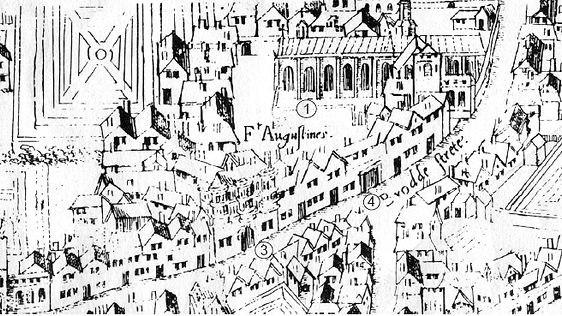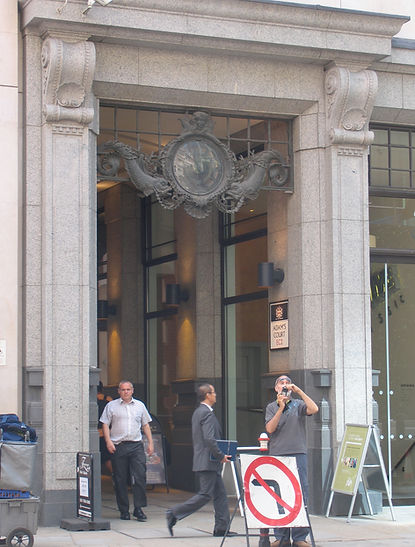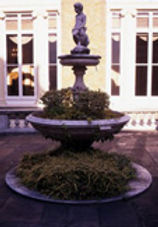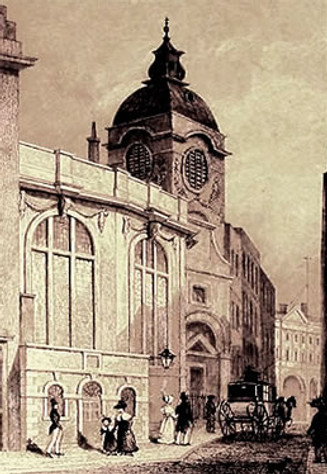Austin Friars, Adams Court and Finch Lane

Austin Friars by John Crowther
Links - Austin Friars
British Library - Points of View - One in a series which compares 19th century and modern photos of the same place, with a little bit of history thrown in for good measure
Archives of the Dutch Church - An online book - no index but all the baptisms, marriages, burials, etc.
The Austin Friars - From the wonderful British History online site, comes this 1909 history of the Austin Friars in London.
A Guide to the Alleys, Courts, Passages and Yards of Central London - A comprehensive list of streets, indexed and with little titbits of information, old and new by Ivor Hoole. Alas the original site has been removed, but The Underground Map website has reproduced the information. Many thanks to them.
I was already somewhat fascinated by the City of London and its laneways, and in particular Austin Friars and Adams Court, where our ancestor John Mollett spent most of his working life, when I read Hilary Mantel’s wonderful novel Wolf Hall and discovered that Thomas Cromwell had his home there. And then on my 2010 trip to England I was able to visit and see for myself - much changed from Cromwell’s day of course, but fascinating nevertheless. The warren of little lanes and squares shown on the beautiful Horwood map at right, is still largely intact, albeit with many more modern buildings. Then further delving into the family history turned up the Smiths, also working in Austin Friars and also in Finch Lane which is very close by, sometimes with Christian Sundius, another ancestor, who also seems to have been in Adams Court for a while. The three families became intimately connected, both at work and in life in more ways than one. So here are a few words and pictures of these three city of London workplaces.
They are very, very close to each other. The map shows how central to London’s financial district they are. Austin Friars is just to the north of Broad Street and Throgmorton Street, between them and Winchester Street near the top fo the map. It has narrow entrances at both ends and opens into a pleasant little square which houses the Dutch church. Adams Court is just across Broad Street. Finch Lane, where Richard Smith worked starts on the other side of Threadneedle Street and runs down to Cornhill. The South Sea House, home of the Baltic Exchange for decades, is at the extreme right of the map on Threadneedle Street. The Bank of England and the Royal Exchange, dominate the area of course, and nowadays the Gherkin looms over it all. The Horwood Map is online here.

Austin Friars and Austin Friars Passage


The friary of the Austin Friars that gives the street its name was founded in 1253 and continued there, with various expansions until the dissolution of the monasteries under Henry VIII. (Austin is an abbreviation of Augustine apparently). The church was then given to the Dutch and part of the original church is still incorporated in the Dutch Church that stands on the site there still. As I briefly mentioned above, the most famous occupant of Austin Friars however, was Thomas Cromwell who built himself a huge mansion there, taking over various existing properties in the process. The house is no longer there, and the Drapers’ Hall now stands where it once was. On the 1550 copperplate map, below left the house with the number 3 below it is Cromwell's. There were several other large mansions in the street, some with gardens, but there were also a large number of business premises. One of the mansions is shown below.






Our ancestor John Mollett sometimes gives his address as Austin Friars and sometimes as Austin Friars Passage, specifically, on one occasion, at 1 Austin Friars Passage. Austin Friars Passage is the very narrow space running between Winchester Street, at the top of the map, and Austin Friars itself. Its entrance is the narrow opening at the foot of the steps as shown in the pictures of no.10 Austin Friars on the right. And below are some modern photos of the Passage.
When I visited in 2010 it was difficult to see where the entrances to potential offices might have been in the passage, although there are obviously doors. They just seemed to be back doors though. But then that is today. Looking at the map at the top of the page, they can’t have been very pleasant spaces - would there have been any windows for example?
Adams Court, it seems, is named after Thomas Adams, who became a Lord Mayor of London in the early seventeenth century and was also a Master of the Worshipful Company of Drapers, whose headquarters is just across the road where Thomas Cromwell's house had stood. Today it has an imposing entry, a rather nice courtyard section with a rather posh restaurant and an arcade with the Gherkin towering over it all. The plan below right is from the British Library’s collection and is dated 1761. This is the first business address we have for our ancestor John Mollett. As Christian Sundius also worked there, it is possible that there was some sort of connection, but then again it could just be a coincidence. The plan shows that the spaces are a mixture of shops, warehouses and residences.

Adams Court
Finch Lane






Links - Finch Lane
London Past and Present: Its History, Associations and Traditions - A Google book by Henry Benjamin Wheatley and
Peter Cunningham, published in 1891. Always interesting to read contemporary accounts. Alas not all of the book is available - in this case - just Finch Lane.
Links - London generally
Horwood's Plan of London 1792-1799 This is a beautiful and very detailed map of London. This site allows you to zoom in and out, and to compare with modern street maps.
Lockie's Topography of London 1810 - an online book by John Lockie which claims to give a concise description of every street in London.
Finch Lane was originally called Finke Lane (or Fynkislane) after Robert Finke who built the church - the parish church of St. Benet. The church was, in fact called St. Benet Finke. It was one of the London churches that was destroyed in the Great Fire of London, but it was rebuilt by Christopher Wren, and stood at the top of Finch Lane in Threadneedle Street, until it was demolished in the 1840s, in order to accommodate the rebuilding of the Royal Exchange.
According to London Past and Present, published in 1891, the street was mostly inhabited by stock and insurance brokers. James Watt worked here for a while, but otherwise there is not a lot to say about it. Rather nice looking restaurant behind the glorious metalwork shutters on the left in the photograph and The Woolpack pub seems to be pretty well known.
The Richard Smiths, together with Christian Sundius, had offices here.,



